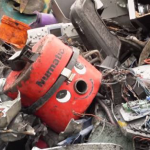Simply put; anything with a plug.
The Waste Electrical and Electronic Equipment Directive (WEEE Directive) was introduced in January 2007.
The WEEE Directive aims to reduce the amount of electrical and electronic equipment being produced and to encourage everyone to reuse, recycle and recover it.
The WEEE Directive aims to minimise the amount of WEEE householders throw out with their general rubbish.
Householders should now find it easier to recycle their old equipment through a mixture of improved local authority civic amenity sites and new take-back facilities provided by retailers. These are operating now.
By keeping WEEE separate from other waste it can be treated, the hazardous substances can be removed and a large amount of waste can be recycled rather than sent to landfill.
Householders can:
- ask the retailer if they’ll take products back
- take old appliances to their local civic amenity site
- arrange for their local authority to collect the equipment (some local authorities provide a free collection service and others charge)
- arrange for an electrical retailer delivering new equipment to take away the old appliance
Note: householders are now covered by the duty of care and must ensure they only pass their waste to a registered waste carrier or other approved person.
The WEEE Directive also aims to improve the environmental performance of businesses that manufacture, supply, use, recycle and recover electrical and electronic equipment.
More information about the WEEE Directive and how it affects you can be found on the Environmental Agency website:
www.environment-agency.gov.uk/business/topics/waste/139283.aspx


